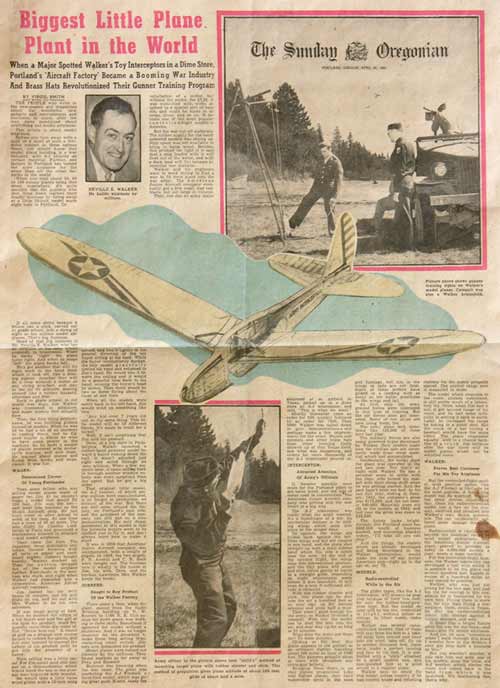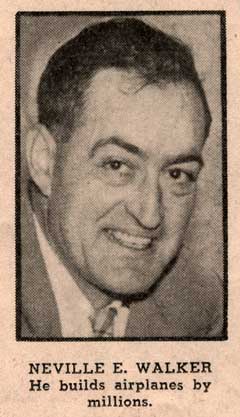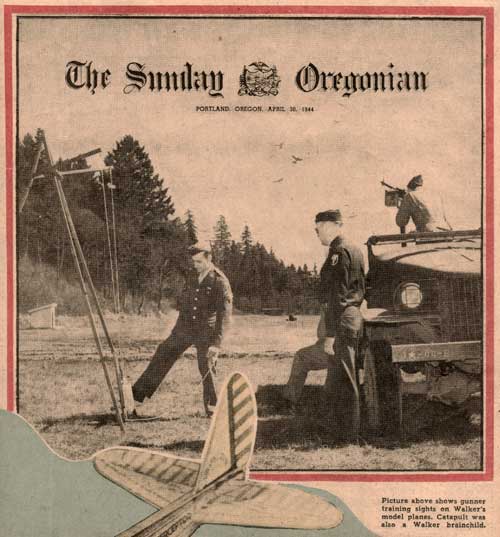
"Biggest Little Plane Plant in the World"
When a Major Spotted Walker's Toy Interceptors in a Dime Store,
Portland's "Aircraft Factory" Became a Booming War Industry
And Brass Hats Revolutionized Their Gunner Training Program.
BY VIRGIL SMITH
Staff Writer, The Oregonian, 1944

THE PEOPLE who write in the newspapers and magazines about the wonderful new gadgets and conveniences and machines to come, after the war, have mentioned about everything but model airplanes.
This article is about model airplanes.
Before you turn away with a sniff or a snort at such a frivolous subject in these serious times, you should know that model plane building is a war industry, with A-l priority on certain material. Further, one factory in Portland has turned out more airplanes for the Army than all the other factories in the world.
When you read about 50, 60 or 100 enemy planes being shot down somewhere, it's quite possible that the gunners who shot them down learned their deadly business by firing away at a little 19-inch model made right here in Portland, Oregon.
 It all came about because a fellow ran a stick, carved out in grade school, into a string of eight or ten million model airplanes. That's big business.
It all came about because a fellow ran a stick, carved out in grade school, into a string of eight or ten million model airplanes. That's big business.
Head of that big business is Mr. Neville E. Walker, who has an airplane in his shop that responds to commands. When he barks "right" the plane turns right. And when he snaps "left" the plane banks left.
He's got another that will fly right back to the hand from which it took off, like a homing pigeon. Another that will do a loop without a motor or any string attached, and stay in the air 30 minutes, soaring around like a turkey buzzard, effortless and free.
Back in grade school, in old World War I days, Jim Walker was interested in airplanes, and made models that actually flew.
Then, the first thing anybody knew, he was building gliders instead of models. When he was 18 he had a bit of an accident in coming down, and he figured maybe it would be wise to have some power in the machine. So he built a couple of planes powered with motorcycle engines, and sold them. He learned about planes and flying from books and experience. It was fun.
WAGER: Determined Career Of Young Portlander
Then some fellow who was selling model planes made of paper bet Jim $5 he couldn't make a model that would fly 200 feet. Jim won the bet and went into business as the Model Aircraft Shop. He had boys come in after school to work in his shop. At one time had a crew of 40 or more. The solo flight by Charles Lindbergh to Paris had generated a tremendous interest in aviation and model airplanes.
Then came the Japs. The Japanese, those inimitable imitators, flooded America with all sorts of paper and cardboard models. Jobbers bought heavily, dealers stocked up. Then the bottom dropped out of the model airplane market. Everybody in the business was stuck, and right when Walker had expanded into a corporation, American Junior Aircraft company.
Jim loaded his car with boxes of samples, put his golf clubs on top, and set out with Mrs. Walker to be his own salesman.
It was tough going at first. When he entered the office of a toy buyer and told the girl at the desk his product, word frequently came from the inner office, "throw him out." A round of golf on a strange new course helped to restore his spirits, and Jim soon learned to conceal the nature of his product until he got into the presence of a buyer.
Then selling was a little easier. For Jim could (and still can) put on a demonstration which would leave the boy in the average man bug-eyed with wonder. He would take a little balsa wood glider with a 12-inch wing spread, and toss it lightly in the general direction of the toy buyer sitting at his desk. While the buyer involuntarily ducked, the tiny model gracefully circled his head and returned to Jim's hand. He would toss it toward the ceiling and it would do a graceful loop back to his hand, missing the buyer's head by inches. Then there would be two or three flying about the room at one time.
When all the models were safely back in his left hand, Jim would wind up something like this: "Any kid over 7 years old can do the same thing. This little model will do 19 different stunts. It's made to retail for a nickel."
Well, it isn't surprising that Jim sold his product.
Once, at a big store in Philadelphia, Walker launched a rubber-band powered model toward a buyer coming down the hall. It wasn't adjusted just right and sailed through, an open window. When a few moments later, it came sailing back in through another window nobody was more surprised than the agent. But he got a big order.
 That original little model, the A-J bomber, of which several million were manufactured, is no longer in production, on account of the war. But there are still some around the factory, on Portland's east side, and the president of the company can still put on a nice demonstration. His only disappointment in this model is that the juvenile buyers seem to be content just to fly it, and don't always learn how to make it stunt.
That original little model, the A-J bomber, of which several million were manufactured, is no longer in production, on account of the war. But there are still some around the factory, on Portland's east side, and the president of the company can still put on a nice demonstration. His only disappointment in this model is that the juvenile buyers seem to be content just to fly it, and don't always learn how to make it stunt.
It was in 1929 that American Junior Aircraft company was incorporated, with a couple of angels. In 1936, the two angels. F. N. Averill and C. R. Bach were bought out. The business now is wholly in the hands of Jim, his wife, Dora, and his brother, Lawrence. Mrs. Walker keeps the books.
JOBBERS: Sought to Buy Product Of the Walker Factory
There came a time, when the plant, moved from the Rudie Wilhelm building on N. W. Everett to 1166 N. E. 31st avenue for more space, was working in three shifts. Sometimes it operated for weeks without a shutdown. And it was no longer essential for the president to make those long selling trips, contacting retail outlets. Jobbers now demanded his product.
Model planes were turned out literally by the millions. They found markets as far away as Peru and Ecuador.
 Business was booming when the war came. The plant, was marketing the A-J Fireball, a three-foot model, which was going great guns. It sold, ready for installation of a motor, but without the motor, for $7.95. It was controlled with wires attached to a special sort of handle, and could be made to do loops, dives, and so on. It became one of the most popular controlled-flight models in America.
Business was booming when the war came. The plant, was marketing the A-J Fireball, a three-foot model, which was going great guns. It sold, ready for installation of a motor, but without the motor, for $7.95. It was controlled with wires attached to a special sort of handle, and could be made to do loops, dives, and so on. It became one of the most popular controlled-flight models in America.
But the war cut off materials. The rubber supply for the band-powered models was drying up. Ship space was not available to bring in balsa wood. Besides, this product (so light it is said that a ship loaded with it will float out of the water, and with a deck load will fly) became an essential war material.
Walker and his engineers went to work trying to find a way to fit their plant into the war effort. The American Junior Aircraft company eventually got a few small war contracts, but not large in volume.
Then, one day an army major stationed at an airfield in Texas, picked up in a dime store an A-J interceptor, and said, "This is what we want."
Shortly thereafter came an order for 500, quickly followed by an order for 1000. Then 5000. Walker was called down to give demonstrations and perhaps make a few improvements for the Army. Majors and colonels and other brass hats from other training fields showed up at that Texas field, saw what was happening, and orders for more thousands of the A-J interceptor poured in.
INTERCEPTOR: Attracted Attention Of Army's Officials
It became possible once more for the Portland plant to get balsa wood, and the bits of metal used in construction. The American Junior Aircraft company was getting into the war effort in a big way.
 The A-J interceptor was really what the army wanted. It's a humdinger of a toy. Its spectacular feature is its folding wings which snap into place at the proper time.
The A-J interceptor was really what the army wanted. It's a humdinger of a toy. Its spectacular feature is its folding wings which snap into place at the proper time.
To operate, the wing's are folded back against the tail. Then wings and tail are clasped in one hand, and the plane shot straight up with a stout rubber band which fits into a notch near the nose. At the end of the upward flight, the wings snap into conventional position, and the tiny plane will zoom and dive, circle gently or travel in a straight glide, depending on slight adjustments made before it was launched. It will even do a loop if sufficient altitude is obtained.
With the rubber shooter and stick, this plane can be shot into the air a hundred feet or so, may stay up for several minutes and glide half a mile.
That wasn't good enough for the army, so Walker invented a catapult. With this, the model can be shot 300 feet into the air, and may stay up for as long as 30 minutes.
What does the army use them for? To train gunners.
Gliding at 300 feet, this plane appears to the gunner as an ordinary fighter traveling about 300 miles an hour at 1500 feet. The gunners actually shoot at them with 50-calibre machine-gun bullets.
Bringing them down is no clay pigeon proposition. Like real fighter planes, they have vulnerable spots in the nose and fuselage, but hits in the wings or tails are not fatal. Some of these models have glided to a landing with as many as ten bullet punctures in the wings and tail.
At first, only the Army ground forces were interested in this type of training. But the air forces soon got interested. Some of our allies are now using them, too.
The Army alone took something like 125,000 of these toys last year (1943).
The military forces are also using powered types developed by Walker. Only models made now for civilian sale are necessarily made from scrap material which had accumulated.
Incidentally, the books show the plant was operated in the red last year. But that's all right with Walker. He has a personal score to settle, with the Japs, who ruined his market with their cheap stuff when he was getting started. And the past hasn't been too had. In his last full year, ending in January, 1942, the company's gross was $175,000, and the net nearly $40,000. Materials were cut off in the middle of 1942, and last year the gross was down to $48,000.
The future looks bright. Already this Portland plant has $800,000 worth of business booked, and numerous blanket orders, "I'll take all you can ship."
And the things, the models which are already developed and being developed in the Walker laboratories, would make the eyes of any junior American pop right up to the age of, say 75.
MODELS: Radio-controlled While in the Air
.jpg) |
Because materials used in radio manufacturing are needed for more important things in the war effort, radio control flying and experiments for it's public use had to be curtailed. Jim Walker, one of radio control models' greatest exponents, built this transmitting set in a suitcase. (Photo from Model Plane Annual - 1943) |
The glider types, like the A-J Interceptor, will always be popular because of their low cost. So will the rubberband-powered type. But the model deluxe will be the one, controlled in flight, without tether or strings. In other words, radio control.
Walker has several radio controlled models. One of them will taxi from his feet to a take-off strip, turn around and head into the wind, take off, fly up to several thousand feet, come back, make a perfect landing and taxi to his feet. It is controlled with a "stick" attached to a small control box, and manipulated just as a pilot would in a regular plane.
Walker says he could fly this model across country if he had control boxes and refueling stations for the motor properly spaced. The control range now is measured in miles.
 The model which responds to the voice, already mentioned, is still pretty much of a laboratory toy. Once, when Jim had it out, it got beyond range of his voice, and he had some difficulty in getting it back to earth. Later, he increased his range by tuning to a pistol shot. But the crack of a bat hitting a baseball would have the same effect. The plane responded equally well to a chance backfire of a truck. Jim believes after the war there will be model planes which can be whistled home.
The model which responds to the voice, already mentioned, is still pretty much of a laboratory toy. Once, when Jim had it out, it got beyond range of his voice, and he had some difficulty in getting it back to earth. Later, he increased his range by tuning to a pistol shot. But the crack of a bat hitting a baseball would have the same effect. The plane responded equally well to a chance backfire of a truck. Jim believes after the war there will be model planes which can be whistled home.
(read more about the sonic control glider)
WALKER: Proves Best Customer For His Toy Airplanes
But the controlled-flight model, with gasoline motor, like the American Junior Fireball is likely to be the most popular. A free flying model can do mischief. Walker has some movies illustrating this. Once his radio-controlled, model lost a tire on the runway, swerved and smashed into Walker's own Buick automobile. The car, incidentally, suffered more damage than the plane.
Radio-control is likely to be beyond the financial range of most model enthusiasts, and the American Junior Aircraft plant, geared to produce as many as 8,000,000 models a year, needs a mass market.
For the controlled-flight business, the Walker laboratory has developed a reel with which it is possible to let the plane out several hundred feet. Speeds in excess of a hundred miles an hour should be possible.
Walker, who was just too young for the last war, and just too old for combat in this one, admits he is fascinated by his own toys. Flying them is more fun for him than flying a real airplane. Once, down in Texas, he sent his radio-controlled model into combat against a turkey buzzard, and won.
It looks like a bright future after the war for the boys and men who fly model airplanes.
And yet, he says, "Sometimes when I walk through this place I wonder how in the dickens I ever got into such a business as this."
But you wouldn't wonder, if you saw him out with one of his models, even the little, old A-J bomber which circles the room and comes back to the hand from which it was launched.
It's fascinating fun, that's why.
Home | Jim Walker | FireWire | Air Mail | Workshop | Short Takes | Fireball | Firebaby